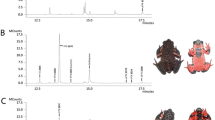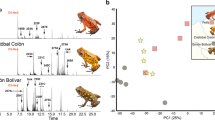Abstract
Seventy skins of three mantellid frog species from Madagascan swamp-forest habitats, Mantella aurantiaca, M. crocea, and M. milotympanum, were individually examined for skin alkaloids using GC/MS. These poison frogs were found to differ significantly in their alkaloid composition from species of Mantella originating from non-flooded rainforest in eastern Madagascar, which were examined in earlier work. Only 16 of the previously detected 106 alkaloids were represented among the 60 alkaloids from the swamp-forest frogs of the present study. We hypothesize this difference is related mainly to habitat but cannot exclude a phylogenetic component as the three swamp-forest species are a closely related monophyletic group. The paucity of alkaloids with unbranched-carbon skeletons (ant-derived) and the commonness of alkaloids with branched-carbon skeletons (mite-derived) indicate that oribatid mites are a major source of alkaloids in these species of mantellids. Furthermore, most of the alkaloids have an oxygen atom in their formulae. Differences in alkaloids were observed among species, populations of the same species, and habitats. In M. aurantiaca, small geographic distances among populations were associated with differences in alkaloid profiles, with a remote third site illustrating even greater differences. The present study and an earlier study of three other mantellid species suggest that oribatid mites, and not ants, are the major source of alkaloids in the species of mantellids examined thus far.







Similar content being viewed by others
References
Andreone F, Cadle JE, Cox N, Glaw F, Nussbaum RA, Raxworthy CJ, Stuart SN, Vallan D, Vences M (2005) Species review of amphibian extinction risks in Madagascar: conclusions from the global amphibian assessment. Conserv Biol 19:1790–1802
Andriamaharavo NR, Garraffo HM, Saporito RA, Daly JW, Razafindrabe C, Andriantsiferana M, Spande TF (2010) Roughing it: a mantellid poison frog shows greater alkaloid diversity in some disturbed habitats. J Nat Prod 73:322–330
Bora P, Dolch R, Jenkins R, Jovanovic O, Rabemananjara CEF, Randrianirina J, Rafanomezantsoa J, Raharivololoniaina L, Ramilijaona O, Raminosoa N, Randrianavelona R, Raselimanana A, Razafimahatratra B, Razafindraibe T, Vences M (2008) Geographical distribution of three species of Malagasy poison frogs of high conservation priority: Mantella aurantiaca, M. crocea and M. milotympanum. Herp Notes 1:39–48
Chiari Y, Vences M, Vieites DR, Rabemananjara F, Bora P, Ramilijaona O, Meyer A (2004) New evidence for parallel evolution of colour patterns in Malagasy poison frogs (Mantella). Mol Ecol 13:3763–3774
Clark VC, Raxworthy CJ, Rakotomalala V, Sierwald P, Fisher BL (2005) Convergent evolution of chemical defense in poison frogs and arthropod prey between Madagascar and the Neotropics. Proc Natl Acad Sci USA 102:11617–11622
Clark VC, Rakotomalala V, Ramilijaona O, Abrell L, Fisher BL (2006) Individual variation in alkaloid content of poison frogs of Madagascar (Mantella; Mantellidae). J Chem Ecol 32:2219–2233
Clarke KR, Warwick RM (2001) Change in marine communities: an approach to statistical analysis and interpretation, 2nd edn. PRIMER-E, Plymouth
Daly JW, Secunda S, Garraffo HM, Spande TF, Wisnieski A, Cover JF Jr (1994) An uptake system for dietary alkaloids in poison frogs (Dendrobatidae). Toxicon 32:657–663
Daly JW, Andriamaharavo NR, Andriantsiferana M, Myers CW (1996) Madagascan poison frogs (Mantella) and their skin alkaloids. Amer Mus Novitates 3177:1–34
Daly JW, Garraffo HM, Spande TF, Clark VC, Ma J, Ziffer H, Cover JF Jr (2003) Evidence for an enantioselective pumiliotoxin 7-hydroxylase in dendrobatid poison frogs of the genus Dendrobates. Proc Natl Acad Sci USA 100:11092–11097
Daly JW, Spande TF, Garraffo HM (2005) Alkaloids from amphibian skin: a tabulation of over eight-hundred alkaloids. J Nat Prod 68:1556–1575
Daly JW, Wilham JM, Spande TF, Garraffo HM, Gil RR, Silva GL, Vaira M (2007) Alkaloids in bufonid toads (Melanophryniscus): temporal and geographic determinants for two Argentinian species. J Chem Ecol 31:871–887
Daly JW, Garraffo HM, Spande TF, Giddings L-A, Saporito RA, Vieites DR, Vences M (2008) Individual and geographic variation of skin alkaloids in three species of Madagascan poison frogs (Mantella). J Chem Ecol 32:252-279 [This paper contains a significant error in Table 7 (pp 266–267) in that the data columns for M. madagascariensis from the Ranomafana and Besariaka sites were interchanged. Tables 3 and 4 where the original data are presented are correct. Other errors were detected in the transcription of data in that paper into the summaries of Tables 7 and 11 as listed in the Erratum for that paper.]
Garraffo HM, Caceres J, Daly JW, Spande TF (1993a) Alkaloids in Madagascan frogs (Mantella): pumiliotoxins, indolizidines, quinolizidines, and pyrrolizidines. J Nat Prod 56:1016–1038
Garraffo HM, Spande TF, Daly JW, Baldessari A, Gros EG (1993b) Alkaloids from bufonid toads (Melanophyrniscus): decahydroquinolines, pumiliotoxins, and homopumiliotoxins, indolizidines, pyrrolizidines and quinolizidines. J Nat Prod 56:357–373
Garraffo HM, Andriamaharavo NR, Vaira M, Quiroga MF, Heit C, Spande TF (2012) Alkaloids from single skins of the Argentinian toad Melanophryniscus rubriventris (ANURA, BUFONIDAE): an unexpected variability in alkaloid profiles and a profusion of new structures. Springer Plus 1:51
Glaw F, Vences M (2007) A field guide to the amphibians and reptiles of Madagascar, 3rd Edition. Cologne, Vences & Glaw Verlag, Germany
Hantak MM, Grant T, Reinsch S, McGinnity D, Loring M, Toyooka N, Saporito RA (2013) Dietary alkaloid sequestration in a poison frog: An experimental test of alkaloid uptake in Melanophryniscus stelzneri (Bufonidae). J Chem Ecol 39:1400–1406
Jones TH, Gorman JST, Snelling RR, Delabie JHQ, Blum MS, Garraffo HM, Jain P, Daly JW, Spande TF (1999) Further alkaloids common to ants and frogs: decahydroquinolines and a quinolizidine. J Chem Ecol 25:1179–1193
Jones TH, Zottig VH, Robertson HG, Snelling RR (2003) The venom alkaloids from some african Monomorium species. J Chem Ecol 29:2721–2727
Rabemananjara FCE, Rasoamampionona Raminosoa N, Ravoahangimalala Ramilijaona O, Rakotondravony D, Andreone F, Bora P, Carpenter AI, Glaw F, Razafindrabe T, Vallan D, Vieites DR, Vences M (2008a) Malagasy poison frogs in the pet trade: a survey of levels of exploitation of species in the genus Mantella. In: Andreone F (editor) A conservation strategy for the amphibians of Madagascar. Monografie del Museo Regionale di Scienze Naturali di Torino 45:277–300
Rabemananjara FCE, Bora P, Razafindrabe TJ, Randiamitso E, Ravoahangimalala Ramilijaona O, RaSamampionona Raminosoa N, Rakotondravony D, Vieites DR, Vences M (2008b) Rapid Assessment of population sizes in ten species of Malagasy poison frogs, genus Mantella. In: Andreone, F. (ed) A conservation strategy for the amphibians of Madagascar. Monografie del Museo Regionale di Scienze Naturali di Torino 45:253–264
Rodríguez A, Poth D, Schulz S, Vences M (2010) Discovery of skin alkaloids in a miniaturized eleutherodactylid frog from Cuba. Biology Lett B 414–418
Saporito RA, Donnelly MA, Garraffo HM, Spande TF, Daly JW (2006) Geographic and seasonal variation in alkaloid-based chemical defenses of Dendrobates pumilio from Bocas del Toro, Panama. J Chem Ecol 32:795–814
Saporito RA, Donnelly MA, Jain P, Garraffo HM, Spande TF, Daly JW (2007a) Spatial and temporal patterns of alkaloid variation in the poison frog Oophaga pumilio in Costa Rica and Panama over 30 years. Toxicon 50:757–778
Saporito RA, Donnelly MA, Norton RA, Garraffo HM, Spande TF, Daly JW (2007b) Oribatid mites as a major dietary source for alkaloids in poison frogs. Proc Natl Acad Sci USA 104:8885–8890
Saporito RA, Spande TF, Garraffo HM, Donnelly MA (2009) Arthropod alkaloids in poison frogs: a review of the ‘dietary hypothesis’. Heterocycles 79:277–297
Saporito RA, Donnelly MA, Madden AA, Garraffo HM, Spande TF (2010) Sex-related differences in alkaloid chemical defenses of the dendrobatid frog Oophaga pumilio from Cayo Nancy, Bocas del Toro, Panama. J Nat Prod 73:317–321
Saporito RA, Norton RA, Andriamaharavo NR, Garraffo HM, Spande TF (2011) Alkaloids in the mite Scheloribates laevigatus: Further alkaloids common to oribatid mites and poison frogs. J Chem Ecol 37:213–218
Saporito RA, Donnelly MA, Spande TF, Garraffo HM (2012) A review of chemical ecology in poison frogs. Chemoecology 22:159–168
Smith BP, Tyler MJ, Kaneko T, Garraffo HM, Spande TF, Daly JW (2002) Evidence of biosynthesis of pseudophrynamine alkaloids by an Australian myobatrachid frog (Pseudophryne) and for sequestration of dietary pumiliotoxins. J Nat Prod 65:439–447
Takada W, Sakata T, Shimano S, Enami Y, Mori N, Nishida R, Kuwahara Y (2005) Scheloribatid mites as the source of pumiliotoxins in dendrobatid frogs. J Chem Ecol 31:2403–2415
Vences M, Kniel C (1998) Mikrophage und myrmecophage Ernährungsspezialisierung bei madagassischen Giftfröschen der Gattung Mantella. Salamandra 34:245–254
Vences M, Glaw F, Böhme W (1998) Evolutionary correlates of microphagy in alkaloid-containing frogs (Amphibia: Anura). Zool Anz 236:217–230
Vences M, Glaw F, Böhme W (1999) A review of the genus Mantella (Anura, Ranidae, Mantellinae): taxonomy, distribution and conservation of Malagasy poison frogs. Alytes 17:3–72
Vences M, Chiari Y, Raharivololoniaina L, Meyer A (2004) High mitochondrial diversity within and among populations of Malagasy poison frogs. Mol Phyl Evol 30:295–307
Vieites DR, Chiari Y, Vences M, Andreone F, Rabemananjara F, Bora P, Nieto-Román S, Meyer A (2006) Mitochondrial evidence for distinct phylogeographic units in the endangered Malagasy poison frog Mantella bernhardi. Mol Ecol 15:1617–1625
Vieites DR, Wollenberg KC, Andreone F, Kohler J, Glaw F, Vences M (2009) Vast underestimation of Madagascar’s biodiversity evidenced by an integrative amphibian inventory. Proc Natl Acad Sci USA 106:8267–8272
Woodhead C, Vences M, VIEites DR, Gamboni I, Fisher B, Griffiths RA (2007) Specialist or generalist? Feeding ecology of the Malagasy poison frog Mantella aurantiaca. Herpetological J 17:225–236
Zimmerman H, Andrianarivo C (2000) La protection de la biodiversité des forêts et des marais de Torotorofotsky à Andasibe, Madagascar-Est. In: Lourenco WR, Goodman SM (eds) Diversity and endemism in Madagascar. Mémoires de la Société de Biogeographie, Paris, pp 261–272
Acknowledgments
Research in Madagascar was made possible by collaboration with the Département de Biologie Animale, Université d’Antananarivo, and research and export permits (CITES export permits # 1100-EAL/MG01/CWO from 19 December 2001 and 070C to 074C-EA02/MG05 from 18 Feb 2005) kindly issued by the Malagasy authorities. The Volkswagen Foundation, Biopat, and the Deutsche Forschungsgemeinschaft supported fieldwork of M.V. and D.R.V. The work at NIH was supported by intramural funds of NIDDK.
Author information
Authors and Affiliations
Corresponding author
Electronic supplementary material
Below is the link to the electronic supplementary material.
Online Resource 1
(PDF 105 kb)
Online Resource 2
(DOC 106 kb)
Online Resource 3
(PDF 273 kb)
Online Resource 4
(PDF 504 kb)
Online Resource 5
(PDF 78.4 kb)
Online Resource 6
(PDF 448 kb)
ESM 1
(PDF 83.7 kb)
Rights and permissions
About this article
Cite this article
Andriamaharavo, N.R., Garraffo, H.M., Spande, T.F. et al. Individual and Geographic Variation of Skin Alkaloids in Three Swamp-Forest Species of Madagascan Poison Frogs (Mantella). J Chem Ecol 41, 837–847 (2015). https://doi.org/10.1007/s10886-015-0616-4
Received:
Revised:
Accepted:
Published:
Issue Date:
DOI: https://doi.org/10.1007/s10886-015-0616-4




